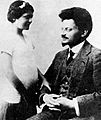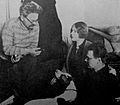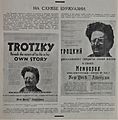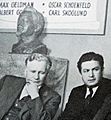Leon Trotsky facts for kids
Quick facts for kids
Leon Trotsky
|
|
|---|---|
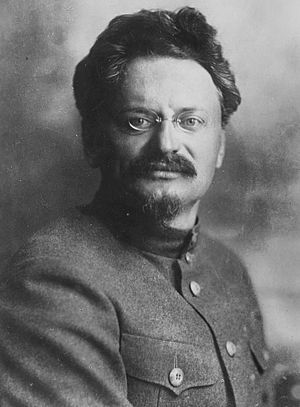
Photograph of Trotsky that appeared on the cover of the magazine Prozhektor in January 1924
|
|
| People's Commissar of Military and Naval Affairs of the Soviet Union | |
| In office 13 March 1918 – 6 January 1925 |
|
| Premier | |
| Preceded by | Nikolai Podvoisky |
| Succeeded by | Mikhail Frunze |
| People's Commissar for Foreign Affairs of the RSFSR | |
| In office 8 November 1917 – 13 March 1918 |
|
| Premier | Vladimir Lenin |
| Preceded by | Mikhail Tereshchenko |
| Succeeded by | Georgy Chicherin |
| Chairman of the Petrograd Soviet | |
| In office 8 October – 8 November 1917 |
|
| Preceded by | Nikolay Chkheidze |
| Succeeded by | Grigory Zinoviev |
| Full member of the 6th, 7th, 8th, 9th, 10th, 11th, 12th, 13th, 14th Politburo | |
| In office 10 October 1917 – 23 October 1926 |
|
| Personal details | |
| Born |
Lev Davidovich Bronstein
7 November 1879 Yanovka, Yelisavetgradsky Uyezd, Kherson Governorate, Russian Empire (now Ukraine) |
| Died | 21 August 1940 (aged 60) Coyoacán, Mexico City, Mexico |
| Cause of death | Assassination |
| Citizenship |
|
| Nationality |
|
| Political party |
|
| Spouses |
|
| Children |
|
| Signature |  |
Leon Davidovich Trotsky (Russian: Лев Давидович Троцкий) was a very important Russian revolutionary and political thinker. He was born Lev Davidovich Bronstein on November 7, 1879, in what is now Ukraine. He was a socialist and believed in the ideas of Marxism, which is a way of thinking about society and economics.
Trotsky played a big part in the Russian Revolution of 1917. He helped the Bolshevik party, led by Vladimir Lenin, take power. He then became the leader of the Red Army during the Russian Civil War, helping to defend the new communist government. After Lenin died, Trotsky had a big disagreement with Joseph Stalin over who should lead the country. Trotsky lost this power struggle and was forced to leave Russia. He lived in different countries before settling in Mexico. In 1940, he was killed in Mexico by an agent sent by Stalin.
Contents
Early Life and Education (1879–1895)
Leon Trotsky was born Lev Davidovich Bronstein on November 7, 1879. He was the fifth child in a wealthy Jewish family. His parents were David Leontyevich Bronstein and Anna Lvovna. They lived in Yanovka, which was part of the Russian Empire and is now in Ukraine.
When Trotsky was eight years old, his father sent him to the city of Odessa for school. He went to a German-language school there. Over time, this school became more Russian due to government policies.
Political Journey and Exile (1896–1940)
Early Revolutionary Activities
In 1898, Trotsky was arrested because of his revolutionary activities. He was sent away to Siberia. However, he managed to escape in 1902 and went to London. There, he met Vladimir Lenin and wrote for a newspaper called Iskra. This paper was for the Russian Social Democratic Labour Party.
During the Russian Revolution of 1905, Trotsky went back to Russia. He became the chairman of the Saint Petersburg Soviet, which was a council of workers. He was arrested again and sent back to Siberia. But he escaped once more in 1907. After that, he lived in several places like London, Vienna, Switzerland, Paris, and New York.
Role in the Russian Revolution
In 1917, the February Revolution happened in Russia, which led to the fall of the tsar. Trotsky returned to Russia and joined the Bolsheviks. He became the chairman of the Petrograd Soviet. He played a very important part in the October Revolution, which overthrew the temporary government.
In Lenin's first government, Trotsky was put in charge of foreign affairs. He led the talks for the Treaty of Brest-Litovsk, which took Russia out of World War I. From 1918 to 1925, he was in charge of the military and navy. He created the Red Army and led it to victory in the Russian Civil War.
Disagreement with Stalin and Exile
After Lenin died in 1924, Trotsky and Joseph Stalin began a struggle for power. Stalin and his allies won, and Trotsky lost his important jobs. He was removed from the Politburo (a top political group) in 1926. Then he was kicked out of the party in 1927. He was sent away to Alma Ata in 1928 and then forced to leave the country in 1929.
Trotsky lived in Turkey, France, and Norway before moving to Mexico in 1937. While in exile, he wrote many books and articles. He strongly criticized Stalin's rule, which he called Stalinism. In his book The Revolution Betrayed (1936), he said that the Soviet Union had become a "degenerated workers' state" and needed to change. In 1938, he started a new international group called the Fourth International. In 1940, Trotsky was killed at his home in Mexico City by an agent.
Legacy and Influence
People who follow Trotsky's ideas are called Trotskyists. Their beliefs are known as Trotskyism. Today, there are still groups around the world that follow these ideas. Some of the main Trotskyist groups include the Fourth International (post - Reunification) and the Socialist Workers Party in the UK.
In Popular Culture
In the famous novel Animal Farm by George Orwell, the character Snowball the pig is meant to represent Leon Trotsky. The character Napoleon, also a pig, represents Joseph Stalin.
Images for kids
-
Leon Trotsky and Lev Kamenev at Brest-Litovsk negotiations (c. 1917–1918)
-
The dissolution of the Constituent Assembly on 6 January 1918. The Tauride Palace is locked and guarded by Trotsky, Sverdlov, Zinoviev and Lashevich.
-
An antisemitic 1919 White Army propaganda poster depicting Trotsky as Satan. The caption reads, "Peace and Liberty in Sovdepiya".
-
Trotsky with Demyan Bedny near Kazan, 1918
-
Vladimir Lenin, Leon Trotsky, Lev Kamenev motivate the troops to fight on the Soviet-Polish war. 1 May 1920
-
Mikhail Kalinin and Leon Trotsky greet Red Army troops. Polish–Soviet War.
-
Trotsky with Vladimir Lenin and Klim Voroshilov among soldiers in Petrograd in 1921.
-
Red Army troops attack Kronstadt sailors in March 1921.
-
Leon Trotsky, the People's Commissar for Military and Naval Affairs USSR, as the Guard of the October revolution on 14 May 1923
-
Leon Trotsky with Soviet leaders write the letter of defiance to British Foreign Secretary Marquess Curzon of Kedleston in 1923, in a parody of Ilya Repin's Reply of the Zaporozhian Cossacks
-
Andrei Bubnov, Kliment Voroshilov, Leon Trotsky, Mikhail Kalinin and Mikhail Frunze attend The October Revolution parade on The Red Square on 7 November 1924
-
Kalinin and Stalin bearing the coffin of Felix Dzerzhinsky on 22 July 1926. Trotsky can be seen over Kalinin's left shoulder.
-
Trotsky's house, the Yanaros mansion on the island of Büyükada in Turkey, as it appears today. Trotsky lived at the house from April 1929 until July 1933.
-
Trotsky arrives in Mexico, January 1937 with his wife. Artist Frida Kahlo behind them.
-
A Diego Rivera mural depicts Trotsky with Marx and Engels as a true champion of the workers' struggle
See also
 In Spanish: León Trotski para niños
In Spanish: León Trotski para niños












